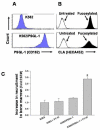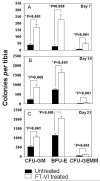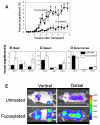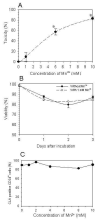Ex vivo fucosylation improves human cord blood engraftment in NOD-SCID IL-2Rγ(null) mice
- PMID: 22306295
- PMCID: PMC3352960
- DOI: 10.1016/j.exphem.2012.01.015
Ex vivo fucosylation improves human cord blood engraftment in NOD-SCID IL-2Rγ(null) mice
Abstract
Delayed engraftment remains a major hurdle after cord blood (CB) transplantation. It may be due, at least in part, to low fucosylation of cell surface molecules important for homing to the bone marrow microenvironment. Because fucosylation of specific cell surface ligands is required before effective interaction with selectins expressed by the bone marrow microvasculature can occur, a simple 30-minute ex vivo incubation of CB hematopoietic progenitor cells with fucosyltransferase-VI and its substrate (GDP-fucose) was performed to increase levels of fucosylation. The physiologic impact of CB hematopoietic progenitor cell hypofucosylation was investigated in vivo in NOD-SCID interleukin (IL)-2Rγ(null) (NSG) mice. By isolating fucosylated and nonfucosylated CD34(+) cells from CB, we showed that only fucosylated CD34(+) cells are responsible for engraftment in NSG mice. In addition, because the proportion of CD34(+) cells that are fucosylated in CB is significantly less than in bone marrow and peripheral blood, we hypothesize that these combined observations might explain, at least in part, the delayed engraftment observed after CB transplantation. Because engraftment appears to be correlated with the fucosylation of CD34(+) cells, we hypothesized that increasing the proportion of CD34(+) cells that are fucosylated would improve CB engraftment. Ex vivo treatment with fucosyltransferase-VI significantly increases the levels of CD34(+) fucosylation and, as hypothesized, this was associated with improved engraftment. Ex vivo fucosylation did not alter the biodistribution of engrafting cells or pattern of long-term, multilineage, multi-tissue engraftment. We propose that ex vivo fucosylation will similarly improve the rate and magnitude of engraftment for CB transplant recipients in a clinical setting.
Copyright © 2012 ISEH - Society for Hematology and Stem Cells. Published by Elsevier Inc. All rights reserved.
Figures






Comment in
-
Re: "Ex vivo fucosylation improves human cord blood engraftment in NOD-SCID IL-2Rγ(null) mice".Exp Hematol. 2012 Jul;40(7):518-9; author reply 519-20. doi: 10.1016/j.exphem.2012.03.004. Epub 2012 Apr 13. Exp Hematol. 2012. PMID: 22507642 No abstract available.
References
-
- Wagner JE, Rosenthal J, Sweetman R, et al. Successful transplantation of HLA-matched and HLA-mismatched umbilical cord blood from unrelated donors: analysis of engraftment and acute graft-versus-host disease. Blood. 1996;88:795–802. - PubMed
-
- Kurtzberg J, Laughlin M, Graham ML, et al. Placental blood as a source of hematopoietic stem cells for transplantation into unrelated recipients. N Engl J Med. 1996;335:157–166. - PubMed
-
- Gluckman E, Rocha V, Boyer-Chammard A, et al. Eurocord Transplant Group and the European Blood and Marrow Transplantation Group Outcome of cord-blood transplantation from related and unrelated donors. N Engl J Med. 1997;337:373–381. - PubMed
-
- Rocha V, Wagner JE, Jr., Sobocinski KA, et al. Graft-versus-host disease in children who have received a cord-blood or bone marrow transplant from an HLA-identical sibling. Eurocord and International Bone Marrow Transplant Registry Working Committee on Alternative Donor and Stem Cell Sources. N Engl J Med. 2000;342:1846–1854. - PubMed
-
- Bensinger WI, Clift R, Martin P, et al. Allogeneic peripheral blood stem cell transplantation in patients with advanced hematologic malignancies: a retrospective comparison with marrow transplantation. Blood. 1996;88:2794–2800. - PubMed
Publication types
MeSH terms
Substances
Grants and funding
LinkOut - more resources
Full Text Sources
Other Literature Sources

